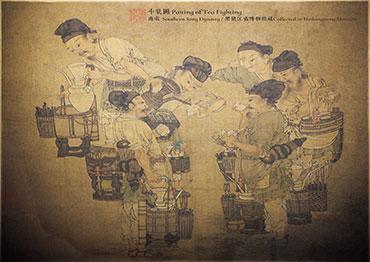The popularity of tea contests reflected changes in the way tea was prepared. The early method was cooked tea (jian cha) which was popular in the Tang Dynasty. The method involved grinding a chunk from a cake of pressed tea leaves into powder. The powder was screened, boiled and served as a thick concoction seasoned with salt, ginger and other ingredients.
In the Song Dynasty, a taste for pure tea developed, and the common way to brew it was by tea whisking (dian cha). All the seasonings were eliminated in this process. Instead, boiling water is added to powdered tea to create a paste, which is then further diluted and frothed with a bamboo whisk.
Tea whisking became a form of entertainment, and required skills for which contests were created.
In the poem “The Song of Tea Contests,” Northern Song Dynasty (960-1127) statesman and writer Fan Zhongyan describes how changes in climate patterns helped Jian’an in Fujian Province replace Huzhou in Zhejiang Province as the major production center for tribute tea. Fujian officials encouraged tea farmers to participate in tea contests and selected the best tea leaves to present to the emperor. People of all social classes participated in tea contests, from the imperial family and literati to monks and common people.
The Northern Song court set up the imperial tea plantation in Beiyuan, an area in Jian’an. Many imperial teas were molded into balls and cakes with embossed images of dragons and phoenixes, earning the name dragon-phoenix tea. The teas were extremely precious, and their value appreciated with time. When paid to the court as tribute, they were wrapped in golden packaging. Tribute teas were made exclusively for the imperial family. We can understand how precious these tea cakes were through the experience of Northern Song poet Ouyang Xiu, who wrote that he drank dragon ball tea once in his more than 20 years of service to the court.
Production improved over time. Ding Wei, who supervised the production of tribute tea in Beiyuan, created a big dragon ball, or 16 balls from about one kilogram of raw tea. His successor, Cai Xiang, remolded it into small dragon balls, or 40 balls from the same amount. Ding and Cai had the same goal – to curry favor with the imperial court, and their strategy worked. Ding became prime minister and the Duke of Jin, while Cai joined the imperial academic institution Hanlin Academy and was named finance minister. Looking to copy their success, many officials scoured the country for new teas to develop. Some even took them by force.
Zheng Kejian, a water transport official, created an exquisite kind of tea that topped both Ding and Cai. He harvested newly grown buds from the tips of tea branches, peeled off the outer layers after steaming, and kept only the most tender leaves. He then soaked them with precious utensils in clear spring water. What remained was a silvery strand, earning it the name “dragon garden snow tea.” The success earned Zheng the position of Fujian governor, who oversaw tea affairs in Beiyuan.
In The Record of Tea, Cai Xiang recorded that tea contests first emerged in Jian’an, the birthplace of famed Tang Dynasty varieties and tribute teas of the Southern Tang Dynasty (937-975). Only the top-ranking teas would be presented to the imperial court. As tea’s prestige increased, tea contests came into fashion.
In Jian’an, in addition to the imperial tea plantation, there were more than 1,000 privately-run tea plantations. With the increased competition, tea contests flourished. Tang Geng, a Northern Song official and poet who was demoted to serve in Fujian, delved into the culture of tea contests and penned the essay “Record of the Tea Contest.” His methods for evaluating tea quality influenced generations.

 Old Version
Old Version


